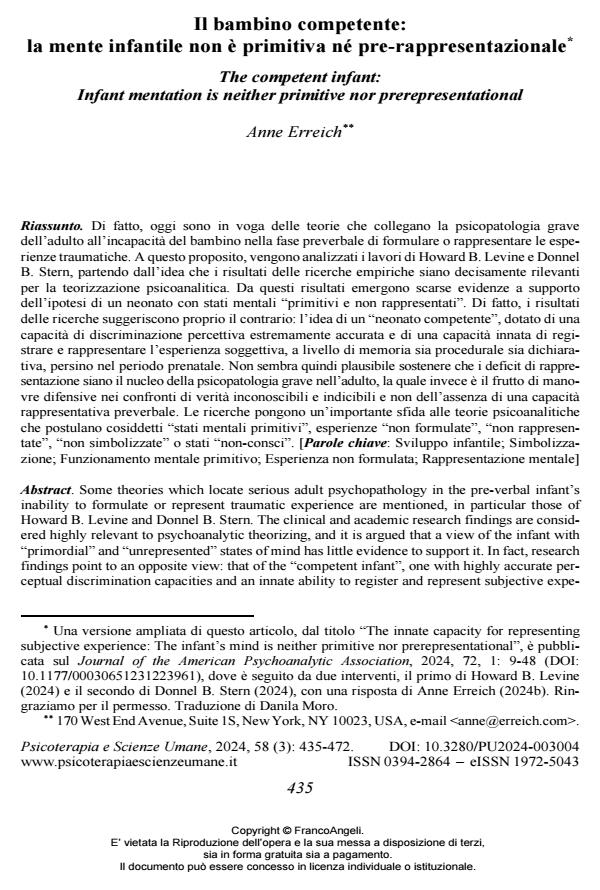Il bambino competente: la mente infantile non è primitiva né pre-rappresentazionale
Titolo Rivista PSICOTERAPIA E SCIENZE UMANE
Autori/Curatori Anne Erreich
Anno di pubblicazione 2024 Fascicolo 2024/3
Lingua Italiano Numero pagine 38 P. 435-472 Dimensione file 199 KB
DOI 10.3280/PU2024-003004
Il DOI è il codice a barre della proprietà intellettuale: per saperne di più
clicca qui
Qui sotto puoi vedere in anteprima la prima pagina di questo articolo.
Se questo articolo ti interessa, lo puoi acquistare (e scaricare in formato pdf) seguendo le facili indicazioni per acquistare il download credit. Acquista Download Credits per scaricare questo Articolo in formato PDF

FrancoAngeli è membro della Publishers International Linking Association, Inc (PILA)associazione indipendente e non profit per facilitare (attraverso i servizi tecnologici implementati da CrossRef.org) l’accesso degli studiosi ai contenuti digitali nelle pubblicazioni professionali e scientifiche
Di fatto, oggi sono in voga delle teorie che collegano la psicopatologia grave dell’adulto all’incapacità del bambino nella fase preverbale di formulare o rappresentare le esperienze traumatiche. A questo proposito, vengono analizzati i lavori di Howard B. Levine e Donnel B. Stern, partendo dall’idea che i risultati delle ricerche empiriche siano decisamente rilevanti per la teorizzazione psicoanalitica. Da questi risultati emergono scarse evidenze a supporto dell’ipotesi di un neonato con stati mentali “primitivi e non rappresentati”. Di fatto, i risultati delle ricerche suggeriscono proprio il contrario: l’idea di un “neonato competente”, dotato di una capacità di discrimina-zione percettiva estremamente accurata e di una capacità innata di registrare e rappresentare l’esperienza soggettiva, a livello di memoria sia procedurale sia dichiarativa, persino nel periodo prenatale. Non sembra quindi plausibile sostenere che i deficit di rappresentazione siano il nucleo della psicopatologia grave nell’adulto, la quale invece è il frutto di manovre difensive nei confronti di verità inconoscibili e indicibili e non dell’assenza di una capacità rappresentativa preverbale. Le ricerche pongono un’importante sfida alle teorie psicoanalitiche che postulano cosiddetti “stati mentali primitivi”, esperienze “non formulate”, “non rappresentate”, “non simbolizzate” o stati “non-consci”.
Parole chiave:Sviluppo infantile; Simbolizzazione; Funzionamento mentale primi-tivo; Esperienza non formulata; Rappresentazione mentale
Anne Erreich, Il bambino competente: la mente infantile non è primitiva né pre-rappresentazionale in "PSICOTERAPIA E SCIENZE UMANE" 3/2024, pp 435-472, DOI: 10.3280/PU2024-003004